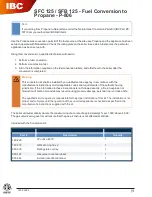
OPTIONAL FEATURES
HeatNet Control V3
Page 63
In low volume systems sudden temperature changes may
occur when the flow is stepped up or down by a large
percentage. In these situations, the SETTINGS: ADAPTIVE
MODULATION: MODULATION MODE may need to be
changed from ADAPTIVE and the ORIGINAL KN method
used. Other adjustments may also be required.
Currently, no failsafe mode is available in the event the
Master boiler’s control fails. If this method is employed, a
failsafe boiler could be used to override the control signal and
enable the system pump’s VFD using some external wiring
and an external relay or have the VFD default to a safe speed
on loss of the control signal.
If (2) pumps are available, pump rotation is available. The
rotation of the (2) pumps can be controlled using two
methods.
3.
Pumps are switched based on the system run time
4.
Pumps are switched by the difference between each
pump’s runtime. The HeatNet control keeps a
running record of each pump’s runtime in hours. If
a pump is taken offline or replaced. The runtimes
can then be adjusted until they become equal.
These features may be selected in the menu, SETTINGS:
SYSTEM PUMP: PUMP ROTATION
The
local circulator pump
is supported by (3) modes and (2)
features.
1.
The first mode allows the circulator pump to remain on,
unless the controls outside high air temperature setting
has been met when using Warm Weather Shutdown.
2.
The second mode will allow the circulator pump to be
turned on whenever there is a call for heat (any control
input). This mode will stop the circulator pump when the
call for heat is lost, and the pump post purge time has
been satisfied.
3.
The third mode works much the same as mode 2, but it
allows the inlet sensor (RETURN) to be used with the
outlet sensor (SUPPLY) to keep the pump on until a delta
(difference) temperature is met. A return temperature
sensor is required for this mode, because the delta
temperature (SUPPLY – RETURN) measured is across
the boiler. In this mode, the post purge time is also used.
After the delta temp has been met, the post purge time
needs to expire before the pump is turned off. This mode
works much the same as mode 2.
Local Pump Options
MASTER PUMP/VALVE REMAINS ON
: This is a special
feature of the local circulator pump to prevent deadheading
water flow when all boilers are off. When this feature is
enabled, the Master boiler will enable its local circulator
pump/valve when
NO
boilers are running. If boilers are
running in LOCAL override and not controlled by H-NET,
but are visible to H-NET, the pump(s) on these boilers are
presumed ON. In this situation, the Master
will not
enable its
circulator pump/valve unless it is running.
Master Valve Remains Open Update
If the boiler was not firing, the local pump/valve post
purge time reduced to 30s, instead of the full post purge
time, and the flow prove time maximum is increased to
600s to allow for longer valve stroke times.
The amount of flow required for a boiler during the
pump post purge period is reduced to the minimum flow
rating of the boiler. This is meant to address the flow
faults the Member boiler was triggering when the
Master opened its valve during the Member’s pump post
purge time, reducing the flow. The system will need to
maintain a little more the twice the minimum flow of the
boilers to still be able to prove flow in post purge with 2
valves open.
We can also use the Local Delay time setting, located in the
DHW settings menu page 2, to require the boiler to prove the
required flow for a certain time period before trying to
fire. This value defaults to 5s but can be increased up to
600s. The boiler will not prove flow, and try to fire, until it
sees the required flow present for the delay time set in the
Local Delay setting. Ideally this value should be set to the
stroke time of the valves to assure all the valves are in their
final position before attempting to fire.
Содержание HEATNET 3.0 Torus Series
Страница 15: ...SETUP OPERATION HeatNet Control V3 Page 15 Mixed Boilers Example Condensing Non Condensing...
Страница 135: ......
















































